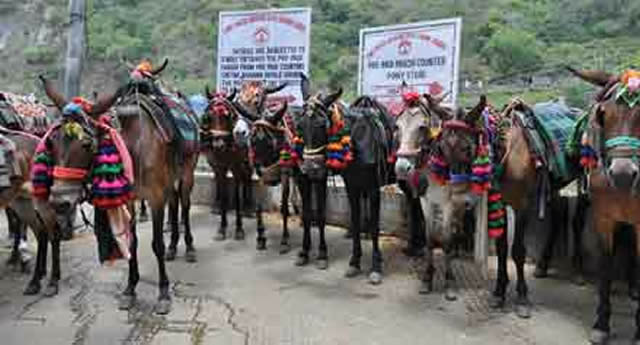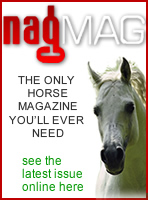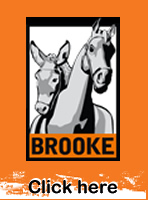
And photographs, if you have any.
Horseytalk.net Special Interview
Rachna Rishi
20,000 mules and horses are used to carry pilgrims to Mata Vaishno Devi. The Brooke is there.
Says Rachna Rishi, Information & Communications Officer, India

Mata Vaishno is a holy cave around 5,200ft up in the folds of a three-peaked mountain called Trikuta. Pilgrims who make the journey are blessed with the darshan (sight) of the Mother Goddess inside the Sanctum Sanctorum - the Holy Cave.
These Darshans are in the shape of three natural rock formations called the Pindies. Devotees throng the shrine from all parts of India and abroad.
From base camp at Katra, it's a 12km hike to the shrine, a journey that many choose to make on one of the thousands of horses and mules which line the start of the track.
More than 20000 mules and horses are used to carry pilgrims to Mata Vaishno Devi. Their owners typically earn about 500 to 1000 INR (£6 - £12) a day.
The shrine is open 24 hours a day throughout the year, and the animals are in constant demand. Not only do they carry many of the pilgrims but also all of the food and drink served at the top.
In 1986, the Shrine Board was formed to manage the Shrine and regulate the journey. While a lot of work has been undertaken to make the journey comfortable for the pilgrims, there is still not enough thought about the animals.
Many are exploited and not provided adequate food, shelter and medical care. While all owners are regulated by a Notified Area Committee (NAC) and required to carry identity cards, their animals often struggle.
A lack of adequate shelter - I discovered animals and their owners in sheds made out of asbestos sheets - often leads to heat stress and dehydration. While most pilgrim carrying animals are fed adequate amounts of fodder, little attention is paid to the quality.
However owners of animals that carry goods often leave their animals out after work leading to an increase in colic. Clean drinking water is also a challenge as the water flowing downhill gets contaminated with the dung on the tracks. A municipal dung disposal unit in Katra is largely ineffective.
As in other areas where tourists gather in numbers, many owners follow the motto, time is money. Even when their animals are in pain they may not allow them to rest. Overworking is common resulting in lameness, stress and dehydration.
Many of the animals are brought in from surrounding areas during the high season (May-July and New Year) but given little time to acclimatise to the high altitude and pushed straight to work even during the night. Numerous mules and horses are kept at the nearby towns of Katra and Ardhakumari but these sites are not spacious enough and lack proper facilities.
For over a thousand years, horses have been shod in iron shoes. In Jammu, the state surrounding the shrine, many horses walk around in rubber shoes, which give better shock absorption and are lighter than metal. However, good hygene is vital to prevent infection.
Brooke India has been working in the area for the past 9 months providing treatments and educating owners on providing better animal welfare such as looking after their horses feet properly (picking them out and cleaning them regularly). In this and other ways the Brooke aims to show owners that looking after their horse's welfare is the best way to ensure that it enjoys a long prosperous and profitable life.



